Auscultation of the heart
Now listen to the heart sounds. In order to auscultate efficiently, you must remember five principles:
1. Sounds originating from each valve tend to be conducted to the surface at a specific point on the surface, hence you should concentrate your listening at each of four places.
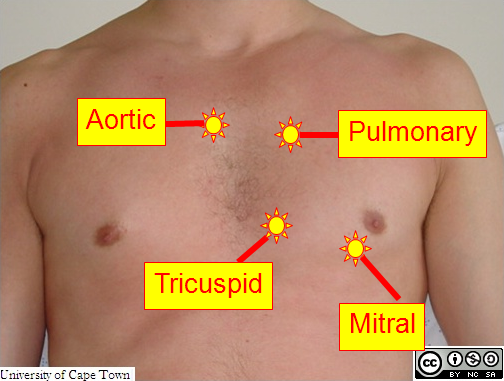
2. Sounds arising from the left-sided valves (mitral and aortic) tend to be louder on expiration, while those from right-sided valves (pulmonary and tricuspid) tend to be louder on inspiration. Therefore you must get your patient to inspire and to expire deeply as you listen in each area.
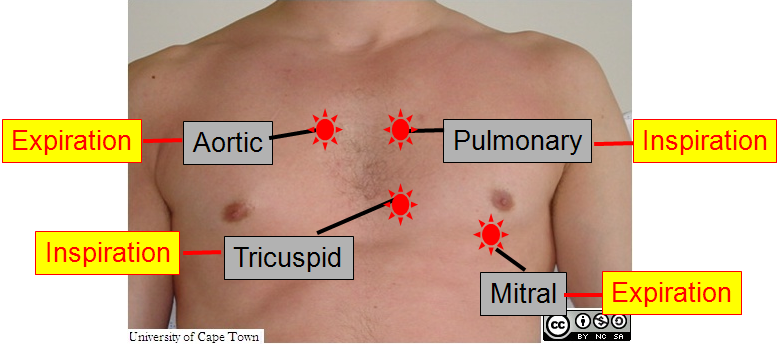
Have your patient breathing deeply, quietly and slowly throughout the examination. If necessary, show him how he should breathe.
| AFRIKAANS | TRANSCRIPT | XHOSA |
|---|---|---|
| I?m going to listen to your heart now. / Ek gaan nou na u hart luister. / Ndiza kumamela intliziyo yakho ngoku | ||
| Deep breath in.../ Asem diep in... / Phefumlela ngaphakathi, | ||
| hold... / hou dit... / Bamba njalo | ||
| When I ask you to breathe, / Wanneer ek u vra om asem te haal... / Xa ndikucela ukuba uphefumle | ||
| this is how I?d like you to do it. / is dit hoe ek wil h?u dit moet doen. / ndingathanda wenze ngolu hlobo. | ||
| Deep breath in and out / Diep asem in en uit. / Phefumlela ngaphakathi ngaphandle | ||
| Hold. / Hou dit. / Bamba njalo. |
3. Sounds arising from those valves placed towards the front of the heart may be accentuated when the patient leans forward, thus throwing the heart against the anterior chest wall. Thus, having listened in the reclining position, you should sit the patient forward and listen to the aortic, pulmonary and tricuspid areas again.
| AFRIKAANS | TRANSCRIPT | XHOSA |
|---|---|---|
| Sit forward. / Sit vorentoe, asseblief. / Hlalela phambili. | ||
| Please sit up./ Sit regop, asseblief. / Ndicela uhlale nkqo. | ||
| I?ll help you./ Ek sal u help. / Ndiza kukuncedisa. | ||
| We need to do the same again. / Ons moet dit nou weer doen. / Kufuneka siphinde kwakhona. |
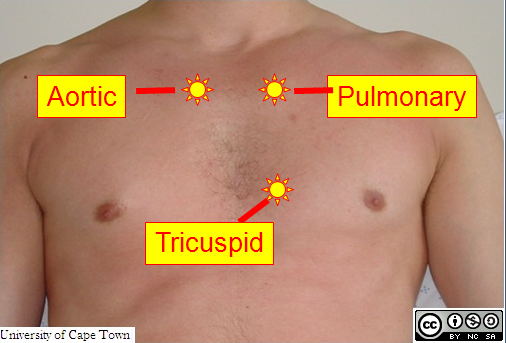
4. Sound arising from the mitral valve tends to be conducted to the apex and may be accentuated when the patient lies on the left side, thus throwing the heart against the left lateral chest wall. Having listened in the reclining and the upright positions, you should lie the patient on his left side and listen to the mitral area.
| AFRIKAANS | TRANSCRIPT | XHOSA |
|---|---|---|
| Deep breath in and out and / Asem diep in en uit en / Phefumlela ngaphakathi ngaphandle | ||
| hold./ hou dit. / Bamba njalo. |
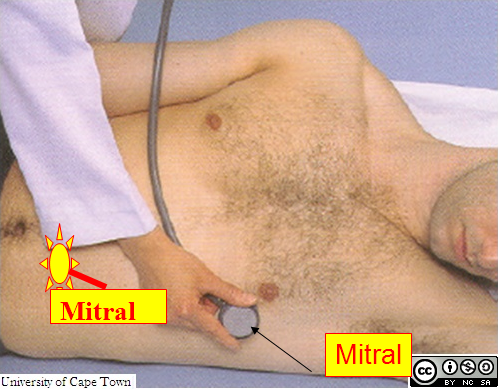
5. The diaphragm of the stethoscope is suited to high-pitched sounds, particularly for pulmonary and aortic murmurs. Use the bell particularly for low-pitched mitral sounds and sometimes for tricuspid murmurs.
For the sake of speed, use the diaphragm in all areas initially: you may use the bell to listen to the tricuspid area when the patient sits forward; when you roll the patient on to his left hand side to listen to the mitral area, use the bell.
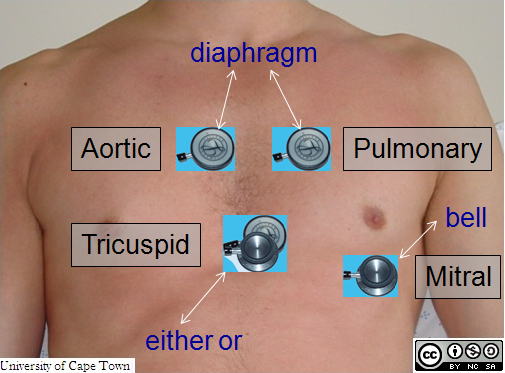
Start by auscultating in all four areas with the patient lying at 45 degrees. Ask the patient to take deep, quiet breaths. Use the diaphragm in all areas, though there is no objection to using the bell in the tricuspid and mitral areas if you wish.
| AFRIKAANS | TRANSCRIPT | XHOSA |
|---|---|---|
| Deep breath in and out. / Asem diep in en uit. / Phefumlela gaphakathi, ngaphandle | ||
| Hold./ hou dit. / Bamba njalo. | ||
| Deep breath in.../ Diep asem in... / Phefumlela ngaphakathi, | ||
| and hold./ en hou dit. / Bamba njalo. |
Now sit the patient forward, and listen with the diaphragm in the pulmonary, aortic and tricuspid areas, in both forced inspiration and expiration. (You may also use the bell in the tricuspid area if you wish.) Concentrate in listening at the end of inspiration in the pulmonary and tricuspid areas, and at the end of expiration in the aortic area. Ask your patient to hold his breath if you need more time to listen.
| AFRIKAANS | TRANSCRIPT | XHOSA |
|---|---|---|
| Deep breath in and out. / Asem diep in en uit. / Phefumlela ngaphakathi ngaphandle | ||
| Hold./ hou dit. / Bamba njalo. | ||
| Deep breath in.../ Diep asem in... / Phefumlela ngaphakathi, | ||
| and hold./ en hou dit. / Bamba njalo. |
Finally turn the patient on to his left side, and listen to the mitral area with the bell, concentrating on the sounds heard after exhalation.
| AFRIKAANS | TRANSCRIPT | XHOSA |
|---|---|---|
| Please turn onto your left side for me. / Draai op u linkersy, asseblief.. / Ndiyakucela ujonge kwicala lasekhohlo. | ||
| Lie on your left side./ L?op u linkersy. / Lala ngeli cala lasekhohlo. |
A murmur can often be accentuated by exercising the patient, so as to increase cardiac output. DO NOT DO THIS.
